
-
What is air? What is the atmosphere?
-
What’s the atmosphere’s role?
-
How was the Earth’s atmosphere formed?
-
Is it true the ancestors of plants created oxygen?
-
Can people live without air?
-
What is healthy air?
-
How do plants keep the air clean for us?
-
Will the air get dirty if forests disappear?
-
What is air pollution?
-
Is polluted air bad for our bodies?
-
What will happen to the Earth if the air becomes polluted?
-
What are people doing to stop air pollution?
-
What can I do to stop air pollution?
What is air? What is the atmosphere?
Air is absolutely necessary for us to live. The Earth is surrounded by air. We call the air surrounding the Earth the atmosphere. The atmosphere is only around 10 kilometers thick. This is less than 1/1,000th of the Earth’s diameter. In other words, the Earth is encircled by a very thin atmosphere.
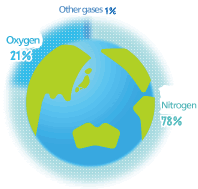
The atmosphere reflects the sun’s light. The atmosphere looks different from day to day, sometimes blues skies, sometimes cloudy skies. Space, on the other hand, doesn’t have air. That’s why the night sky is always pitch black.
The atmosphere is made up of many kinds of gases. However, two gases make up most of the atmosphere. About four-fifths (78%) is nitrogen, and about one-fifth (21%) is oxygen. The remaining 1% includes very small amounts of carbon dioxide, helium, methane, and other gases.
What’s the atmosphere’s role?
What’s the role of the atmosphere, which surrounds the Earth? We are able to live thanks to the Earth having an atmosphere. Animals live by breathing the oxygen in the atmosphere.

There’s a layer of gas called ozone in the upper part of the atmosphere. The ozone layer is very important because it blocks most of the ultraviolet rays from the sun. The ozone layer protects us from ultraviolet rays, which are harmful to living things.
The moon doesn’t have an atmosphere. As a result, temperatures at its equator swing from about 130 degrees Celsius in the daytime to about −170 degrees Celsius at nighttime. Because of our atmosphere, the Earth has a moderate climate, which makes it easy for living things to live.
How was the Earth’s atmosphere formed?
The Earth and the rest of the solar system were formed about 5 billion years ago. Gases swirling around the sun gradually cooled and formed masses called minor planets. One of these minor planets was the Earth. The newly formed Earth was showered by countless minor planets, small meteorites, and other objects. The materials in these minor planets and meteorites were released as gases that eventually formed the atmosphere that covers the earth.
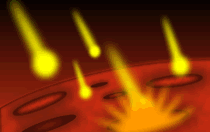
Originally, there was no oxygen in the atmosphere. It was made up mainly of carbon dioxide, water vapor, and methane gas. Not even clouds could form because the atmosphere was so hot and dry. It took a very long time for the atmosphere to become what it is today.
Is it true the ancestors of plants created oxygen?
After it was first formed, the Earth’s atmosphere didn’t have any oxygen like it does today. So when and how did oxygen come about? The clue to answering this question is related to the origin of living things.
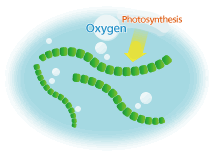
Types of bacteria have been found in old fossils about 3.8 billion years old. The bacteria seem to have used photosynthesis just like modern plants. Photosynthesis is a chemical process that takes carbon dioxide and water and uses the sun’s light to make energy. In this process, photosynthesis produces oxygen. Over a long period of time, these organisms produced lots of oxygen. So gradually the amount of oxygen in the atmosphere increased.
Oxygen was a poisonous gas for living things back then. But as the amount of oxygen in the atmosphere increased, some living things adapted and started to make use of oxygen. These were the ancestors of today’s animals.
Can people live without air?
We live by breathing air. We take in oxygen from the air to produce energy. Oxygen is essential for us to move our bodies and to think about things. You could say oxygen is the source of all energy we need to live.
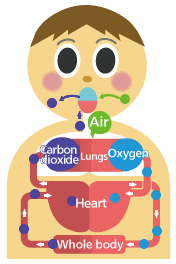
When we breathe in air through our nose and mouth, the air goes to our lungs. When it gets to our lungs, oxygen is taken into our bloodstream. Oxygen is then carried throughout our body through blood vessels. As your blood delivers oxygen, it receives unneeded carbon dioxide in return and carries the carbon dioxide to your lungs. Your lungs exhale the carbon dioxide through your nose and mouth.
Humans aren’t the only living things that live by breathing oxygen in the air. Animals, birds, and insects also need oxygen to survive. And even fish in rivers and oceans breathe oxygen in the water.
What is healthy air?
Because air is invisible, we normally don’t sense the air very much. But some air is healthy and some isn’t.

Some air isn’t healthy because it doesn’t have enough oxygen. If you leave a gas or oil heater on in a closed room, the lack of oxygen will eventually lead to carbon monoxide poisoning, which is very dangerous.
But, then, what is healthy air? Healthy air has plenty of oxygen, isn’t dusty or gritty, and doesn’t have any gases that are bad for our bodies. Have you ever felt refreshed after spending time in the countryside or in a forest where the air is clean? Air that isn’t dirty can feel “delicious”, even though it doesn’t have any taste or smell.
How do plants keep the air clean for us?
Plants produce oxygen through photosynthesis. People and animals breathe the oxygen made by plants. Air is exchanged between plants and animals this way to maintain the balance of oxygen and carbon dioxide in the air. This is why the Earth’s atmosphere never becomes all carbon dioxide or all oxygen.
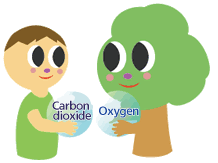
Plants also breathe. So they take in oxygen and put out carbon dioxide. But plants produce much more oxygen through photosynthesis than they take in themselves. For example, if you have a tree, like an oak tree or beech tree, in a 100-square-meter area, it will absorb 30 tons of carbon dioxide and produce 22 tons of oxygen in a year. That’s as much oxygen as 80 people breathe in a year. We should be thankful that plants make oxygen so we can breathe clean air.
Will the air get dirty if forests disappear?
Plants produce oxygen and clean the air. So plants are very important for people and animals. Still, today plants are facing a dangerous time.
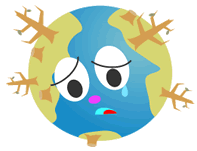
Forests and natural environments are being destroyed in Japan and around the world. In Japan, for example, trees are cut down and hills are leveled to make roads or leisure areas. In other places in the world, tropical forests are being destroyed one after another, as more and more timber is cut from them. It’s said that in the last 50 years, half of all tropical forests have disappeared.
What will happen to the Earth if forests continue to be destroyed? Without plants to absorb carbon dioxide, the amount of carbon dioxide in the air will continue to increase. People and animals will not be able to breathe clean air. So you can see this is a big problem.
What is air pollution?
A big problem is that the atmosphere surrounding the Earth is getting dirty. When gases in the air that make the atmosphere dirty increase, we call this air pollution. Air pollution causes many problems. But it is people who originally created the causes of air pollution.
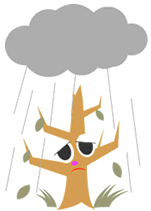
The biggest cause of air pollution is burning things. When we burn oil or coal to produce energy or when we burn large amounts of garbage, substances are created that pollute the atmosphere. For example, smoke from factories and exhaust gas from cars have many substances that cause pollution.
Nitrogen oxides are one kind of polluting substance. We know nitrogen oxides are the cause of photochemical smog. Acid rain, which kills plants, is also caused by nitrogen oxides. Air pollution is very bad near factories or busy roads. But even if there are no factories or big roads nearby, polluted air is still carried by the wind.
Is polluted air bad for our bodies?
What happens to our bodies if we breathe in polluted air? Living in an area with polluted air can damage our throats and lungs. It can even lead to diseases like chronic bronchitis or emphysema.
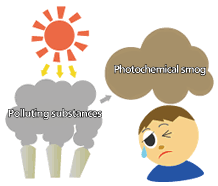
Exhaust gases from cars and polluting substances from factories when exposed to sunlight create photochemical smog. Photochemical smog can irritate and hurt our eyes. Photochemical smog is more likely on days with strong sunlight. It’s best to avoid hard exercise outdoors on such days.
Many factories were built in Japan during the high economic growth period in the 1960s. Gases emitted by the factories back then polluted the atmosphere and caused pollution across the country. Many people in Yokkaichi, Mie Prefecture, and Kawasaki, Kanagawa Prefecture, developed asthma, bronchitis, and similar illnesses. These diseases became known as Yokkaichi asthma and Kawasaki asthma.
What will happen to the Earth if the air becomes polluted?
Let’s think about what would happen to the Earth if it were surrounded by a polluted atmosphere. One worry is destruction of the Earth’s environments due to air pollution.
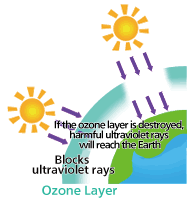
Another problem people often talk about is global warming. When factories and other places burn things, lots of carbon dioxide and other gases are made. Because carbon dioxide traps heat, temperatures will go up. Higher temperatures cause abnormal weather and other problems.
Polluting substances are also the cause of acid rain. Polluting substances emitted by factories and cars are absorbed by clouds, making rain more acidic. Acid rain creates many kinds of damage, including killing forests and crops.
The destruction of the ozone layer is another huge problem. The ozone layer is what protects us from harmful ultraviolet rays from the sun. Fluorinated gases used in aerosols and other products eat away at the ozone layer. If the ozone layer is destroyed, ultraviolet rays will reach the Earth and damage living things.
What are people doing to stop air pollution?
Let’s think about what would happen to the Earth if it were surrounded by a polluted atmosphere. One worry is destruction of the Earth’s environments due to air pollution.
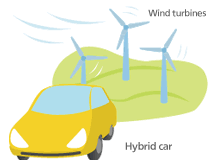
Makers of cars are working to reduce the polluting substances cars produce. They are making engines that run cleaner and adding equipment that cleans exhaust gases. People are also researching electric cars that don’t put out any exhaust gases. It’ll probably take a little longer until electric cars are in wide use. One area people are focusing on now are hybrid cars. Hybrid cars are powered by an engine and an electric motor. As a result, they produce very little carbon dioxide.
Researchers are also studying new kinds of energy that don’t pollute the atmosphere. Thermal power stations, which have been widely used, produce carbon dioxide because they burn oil, coal, or natural gas. People are looking forward to kinds of energy that are friendly to the environment. These include wind turbines that use wind power, solar power that uses sunlight, and geothermal power that uses the heat of magma underground.
What can I do to stop air pollution?
There are lots of things we can do every day to stop air pollution. The main cause of air pollution is burning oil, coal, and other things. We should avoid burning these fuels as much as possible. For example, we should avoid driving cars as much as possible. At home, we should avoid wasting electricity, gas, and oil. So be sure to always turn off lights and appliances when not in use and only use air-conditioning systems when really needed.
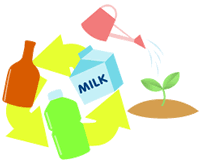
Toxic substances are also produced when garbage is discarded and burned. Remember that when you throw something away, you are also throwing away all the labor and fuel used to make the product. To reduce the amount of garbage, always think about whether something is really necessary when shopping. And be sure to separate your garbage properly, so it can be recycled. We should all try to lead ecofriendly lives by growing plants and spending more time in nature.



